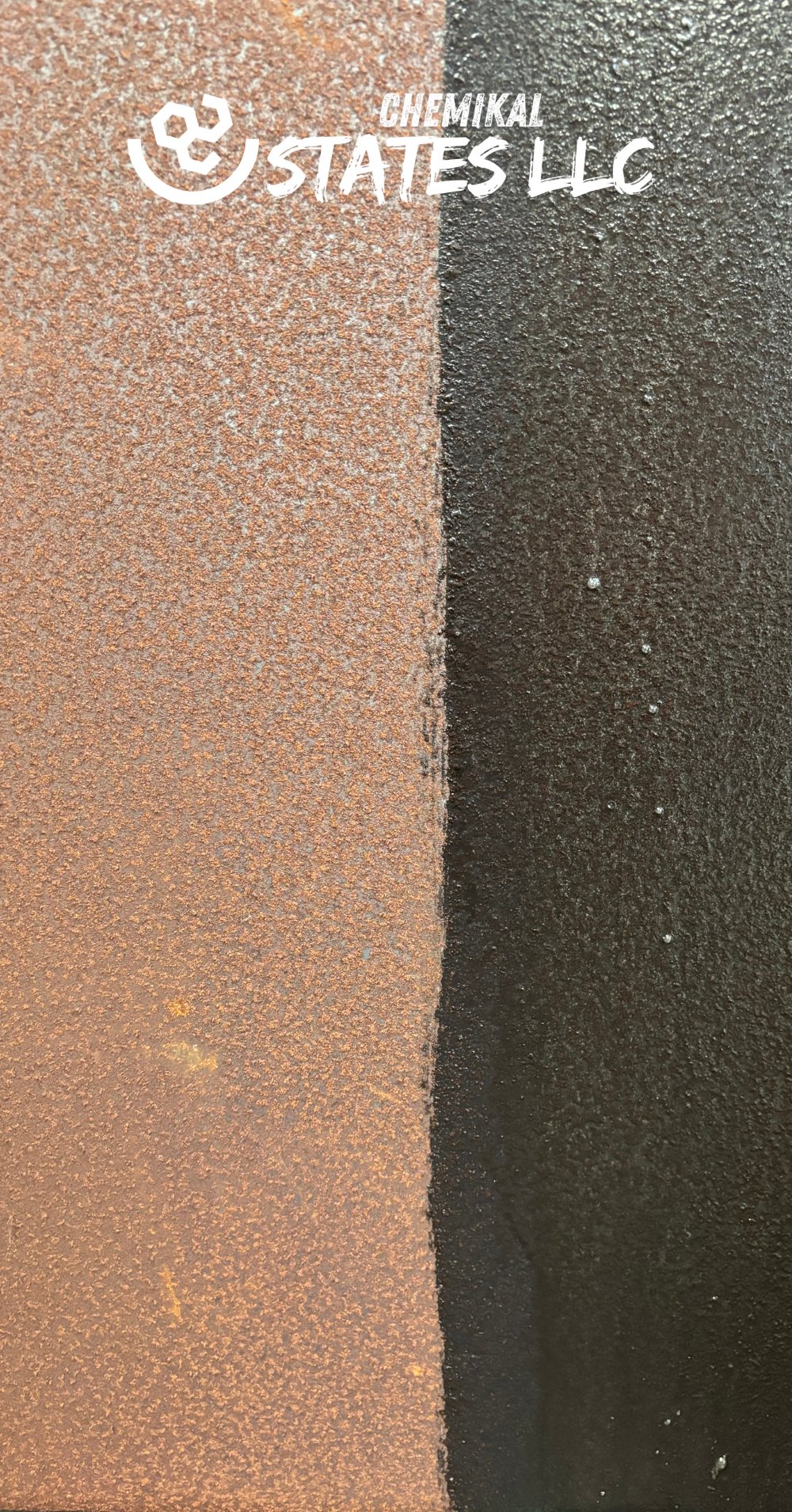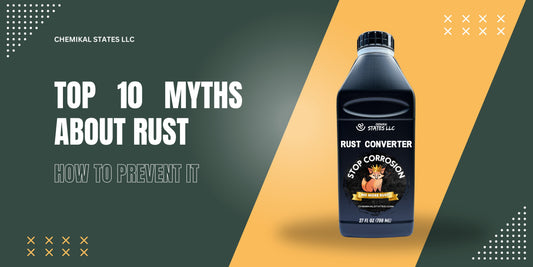
Rust Removers vs. Rust Converters: Why a Rust Converter is the Superior Choice for Metal Restoration
Share
When it comes to dealing with rust on metal surfaces, there are two primary tools at your disposal: Rust Removers and Rust Converters. While both serve the purpose of addressing rust, they operate in fundamentally different ways. If you're looking to protect and restore your metal surfaces effectively, understanding the difference between these two products is crucial. In this blog, we'll explore the pros and cons of each method and explain why a Rust Converter, like the one offered by Chemikalstates.com, is always the better choice.
What is Rust, and Why Does It Need to Be Addressed?
Rust is the result of the oxidation of iron when it comes into contact with moisture and oxygen. Over time, rust can weaken the structure of metal objects, leading to potential safety hazards and a significant reduction in the lifespan of the item. Addressing rust as soon as it appears is crucial to preserving the integrity and appearance of any metal surface.
What is a Rust Remover?
A Rust Remover is a chemical solution designed to dissolve and remove rust from metal surfaces. These products typically contain acids, such as phosphoric or oxalic acid, that break down rust, leaving behind a clean, bare metal surface.
How Does a Rust Remover Work?
When applied to a rusty surface, the acid in the Rust Remover reacts with the iron oxide (rust), dissolving it and making it easy to scrub away. This process can be effective in completely removing rust, but it also requires significant effort, including scrubbing, rinsing, and drying. Once the rust is removed, the metal is left bare and exposed, making it prone to re-rusting if not immediately coated with a protective layer.
Pros of Rust Removers
- Effective at Removing Rust: Rust Removers can completely eliminate rust from a surface, leaving behind bare metal.
- Ideal for Detailed Work: If you need to restore intricate parts or tools, Rust Removers can be ideal for reaching all the nooks and crannies.
Cons of Rust Removers
- Labor-Intensive: Removing rust often requires scrubbing and multiple applications, making the process time-consuming and laborious.
- Leaves Metal Exposed: Once the rust is removed, the metal is left bare and vulnerable to new rust unless quickly protected.
- Hazardous Chemicals: The acids used in Rust Removers can be dangerous to handle, requiring protective gear and careful disposal.
What is a Rust Converter?
A Rust Converter, on the other hand, is a chemical solution that not only halts the rusting process but also transforms the rust into a stable, paintable surface. Rust Converters contain tannic acid and an organic polymer that react with rust to form a protective layer, effectively neutralizing the rust and preventing further oxidation.
How Does a Rust Converter Work?
When applied to rusted metal, the tannic acid in the Rust Converter reacts with the iron oxide, converting it into iron tannate, a dark, stable compound. Simultaneously, the organic polymer creates a protective barrier over the iron tannate, providing a solid base for painting or coating. This process not only stops rust from spreading but also protects the metal from future rust formation.
Pros of Rust Converters
- Stops Rust in Its Tracks: Unlike Rust Removers, Rust Converters neutralize rust, preventing it from spreading and further damaging the metal.
- Creates a Protective Layer: The organic polymer in Rust Converters forms a protective coating, making the surface ready for painting or sealing.
- Easy to Use: Rust Converters require minimal preparation and effort. Simply clean the surface, apply the converter, and let it do the work.
- Long-Term Protection: By converting rust and creating a protective barrier, Rust Converters provide long-term protection against future rusting.
Cons of Rust Converters
- Not for Completely Bare Metal: If you need to work on completely rust-free metal, a Rust Converter isn’t necessary as it’s designed to work with rusted surfaces.
Why a Rust Converter is Always the Better Choice
While both Rust Removers and Rust Converters have their uses, a Rust Converter is typically the superior choice for most metal restoration projects. Here’s why:
1. Long-Term Protection
Rust Removers may effectively eliminate rust, but they leave the metal surface exposed and vulnerable to new rust. In contrast, a Rust Converter not only stops the rust but also creates a protective layer, ensuring that your metal stays rust-free for longer.
2. Ease of Use
Rust Removers require significant effort, including scrubbing, rinsing, and drying. On the other hand, a Rust Converter is incredibly easy to use. After a simple application process, the rust is neutralized, and the metal is ready for painting or sealing with minimal extra work.
3. Safer to Handle
Many Rust Converters, including the high-quality product available at Chemikalstates.com, are water-based and contain fewer harsh chemicals compared to Rust Removers. This makes them safer to use and more environmentally friendly.
4. Versatile Applications
Rust Converters are ideal for a wide range of applications, from automotive restoration to maintaining outdoor structures like fences and gates. Their ability to stop rust and prepare surfaces for painting makes them invaluable in both DIY and professional settings.
Why Choose Chemikalstates.com Rust Converter?
At Chemikalstates.com, we produce one of the best Rust Converters on the market. Our formula is designed to deliver superior results, providing a reliable solution to rust problems with minimal effort. Whether you're tackling a large metal surface or a small, intricate object, our Rust Converter is the perfect tool to restore and protect your metal items.
Features of Our Rust Converter:
- Advanced Chemical Formula: Our Rust Converter uses a powerful blend of tannic acid and polymers to effectively neutralize rust and create a durable protective layer.
- Easy Application: Simply clean the surface, apply the converter, and let it work its magic. There's no need for intensive labor or hazardous chemicals.
- Long-Lasting Protection: The protective layer formed by our Rust Converter not only halts rust but also guards against future corrosion, ensuring your metal surfaces remain in top condition.
Conclusion: Make the Smart Choice for Rust Treatment
When it comes to rust treatment, choosing the right product can make all the difference. While Rust Removers may have their place in certain situations, a Rust Converter is generally the smarter choice for most metal restoration projects. By stopping rust in its tracks and creating a protective layer, a Rust Converter provides long-term protection with minimal effort.
If you're ready to tackle rust and restore your metal surfaces, choose the best Rust Converter available at Chemikalstates.com. Our product is designed to deliver outstanding results, helping you maintain and protect your metal items for years to come.
Don’t let rust ruin your valuable metal surfaces—invest in a high-quality Rust Converter today and enjoy the peace of mind that comes with knowing your metal is protected.
Examples of Rust Converter Applications
Rust Converter is a versatile product that can be used in various situations to protect metal surfaces from further corrosion. Here are some examples of its applications:
1. Car Restoration
Rust Converter is an ideal solution for repairing rust on cars, especially in areas exposed to salt and moisture, such as wheel wells, undercarriages, and doors. After applying the product, the surface is ready for painting, which provides additional protection and enhances the vehicle’s appearance.
2. Repairing Metal Fences and Gates
Metal fences and gates are often exposed to the elements, which can lead to rust formation. Using a Rust Converter allows for quick restoration of these elements without the need for intensive cleaning or replacement.
3. Maintenance of Tools and Garden Equipment
Tools and garden equipment, such as shovels, pruners, or lawnmowers, often rust due to moisture. Applying Rust Converter not only neutralizes the rust but also protects the tools from further damage, extending their lifespan.
4. Protecting Steel Structures
Rust Converter can be used on large steel structures like bridges, towers, or warehouses where rust can pose a significant threat to structural integrity. Neutralizing the rust and preparing the surface for painting prevents further corrosion.
5. Marine Applications
Boats, yachts, and other equipment exposed to saltwater are particularly prone to rusting. Rust Converter is an excellent solution for protecting these metal components from corrosion, especially in harsh marine environments.
Frequently Asked Questions (FAQ)
1. What is the difference between a Rust Converter and a rust remover?
Answer: A Rust Converter does not remove rust but chemically neutralizes it and converts it into a stable, black layer that can be painted. A rust remover, on the other hand, eliminates rust but leaves the metal surface exposed, which can lead to faster rust formation if the surface is not properly protected.
2. Can Rust Converter be used on all types of metal?
Answer: Rust Converter is most effective on iron-containing surfaces because it reacts with the iron to create a stable chemical compound. However, it does not work on surfaces like aluminum or copper, which do not rust in the same way.
3. Is it necessary to paint the surface after applying Rust Converter?
Answer: Although Rust Converter forms a protective layer, painting the surface after its application provides additional protection against environmental factors and long-term corrosion. Painting is recommended to achieve the best protective results.
4. How should the surface be prepared before applying Rust Converter?
Answer: Before applying Rust Converter, you should remove loose rust, dirt, and oil from the surface to ensure good product adhesion. Use a wire brush or scraper, then apply the Rust Converter according to the instructions.
5. Can Rust Converter be used on large surfaces like bridges or towers?
Answer: Yes, Rust Converter is ideal for use on large steel structures where rust can threaten structural integrity. Its easy application makes it suitable for various large-scale surfaces, providing long-term protection against corrosion.
Why the Rust Converter from Chemikalstates.com is the Best Choice
The Rust Converter available at Chemikalstates.com is a top-quality product that delivers effective protection and long-lasting results. Our Rust Converter not only neutralizes rust but also forms a durable protective coating, making it a reliable solution in the fight against corrosion. By choosing our product, you are investing in reliability and professionalism, which translates into better protection for your metal surfaces.










